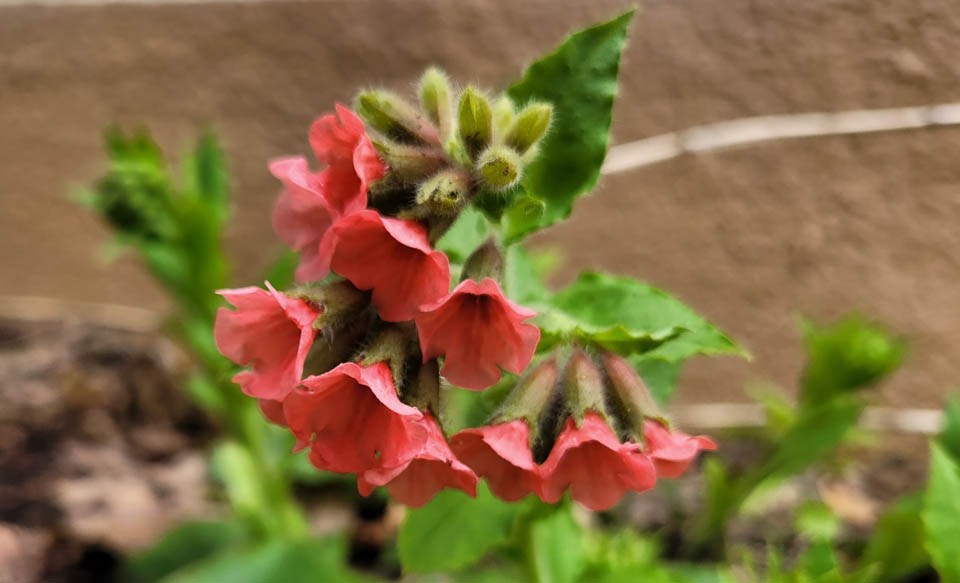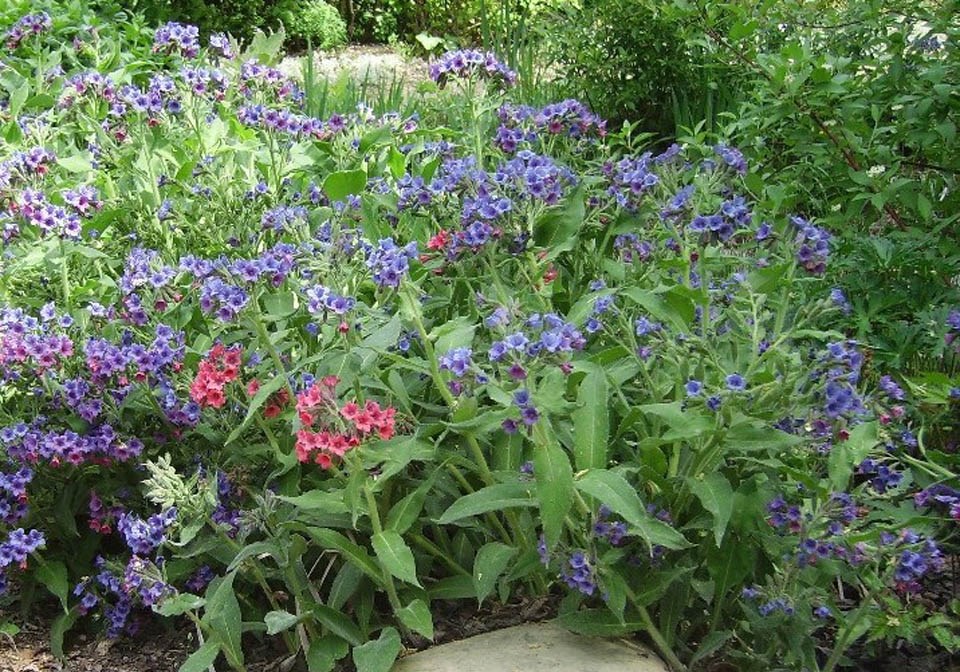As the crocuses and other small spring bulbs start fading from the landscape, Pulmonaria lifts its sleepy head to provide some welcome colour in the early spring garden.
Pulmonaria is an herbaceous perennial consisting of about 18 species in the borginaceae family. About eight of these, native to central and north-eastern Europe, are known in cultivation. Often, garden centres will label them simply as Pulmonaria, as many cultivars have undetermined species in their heritage.
In my garden, the Pulmonaria are planted in a border along the house, facing east to the morning sun. In nature, they are found as is an understorey plant in deciduous forests. So they will thrive in dappled shade rather than deep shade. Many varieties have white spots on their leaves. These are foliar air-pockets used in cooling the lower surface of the leaves. It is believed that varieties with more spots can tolerate sun better and can be planted in lighter locations. The mottled spotted leaves resemble a diseased lung, hence the Latin name for lung, pulmo, and the English name, lungwort, with wort meaning plant.
The most widespread Pulmonaria in Europe is P. officinalis, which has heart-shaped, elongated leaves with white patches and sports small bunches of flowers. The white cultivar,' Sissinghurst White', named after Vita Sackville-West’s garden in Kent, England, is believed to have been developed from this species.
P. angustiflora and P. longiflora are narrow-leaved varieties which are clump-forming. The first one has narrow leaves without the spots, whereas P. longiflora has narrow spotted leaves. The leaves start as heart-shaped but narrow towards the base, where they attach to the stem unstalked, clasping the stem. The leaves and flower stems are hairy. Short tubular flowers develop in tight little clusters. Buds usually have some pink and violet in them. But turn a deep blue when they mature.

Pulmonaria rubra starts blooming close to the ground. | Photo by Bernadette Vangool
I have two varieties in my yard. The red or deep pink variety begins blooming a full two weeks earlier than the blue variety, in early May, but continues its bloom period alongside the blue. It may be a descendant, or perhaps it is P. rubra, which is native to France and Spain. I acquired it at a plant exchange. It has the characteristics of P. rubra in that the foliage is a pale green without spots, with oblong velvety leaves. It grows to a height of about 35 cm. It begins blooming close to ground level and then sends up taller stalks. Last year's evergreen foliage dies back as new growth emerges. Clumps can spread to about 60 cm.
The second variety is one I acquired at the Robin Smith Meditation Garden, where it has naturalized and self-seeds freely. It was used as a ground cover surrounding the pond. This variety has darker green foliage, again without the spots. It grows slightly taller when in bloom, but settles in with foliage that sits about 25cm high the remainder of the year. This is a blue variety.
As stated earlier, Pulmonaria prefer partial shade. Plant them in moist, well-drained, humus-rich soil. They will tolerate clay soils. Keep them consistently moist in hot, dry weather. In the Meditation Garden at the Forestry Farm, I have come across the wilted, dusty foliage of these beauties after a spell of hot, dry weather, when somehow the watering of the gardens had been overlooked. On these occasions, the plants readily recovered after a good soaking. Come spring, they announced the herald of the new season with seemingly few ill effects.
The root system of Pulmonaria is slowly creeping rhizomes and adventitious roots. Plants are best divided in fall, and benefit from division every four to five years, resulting in more vigorous plants. When planting, spread the roots with your fingers and do not bury the crown of the plant, as this will lead to rotting.
Lungworts have few disease or pest problems. In damp weather, it may on occasion develop powdery mildew and slugs may be a problem for some.
Since it blooms so early, it is a good nectar source for bees, butterflies and other pollinators.
This column is provided courtesy of the Saskatchewan Perennial Society (SPS; [email protected]). Check our website (www.saskperennial.ca) or Facebook page (www.facebook.com/saskperennial) for a list of upcoming gardening events.




